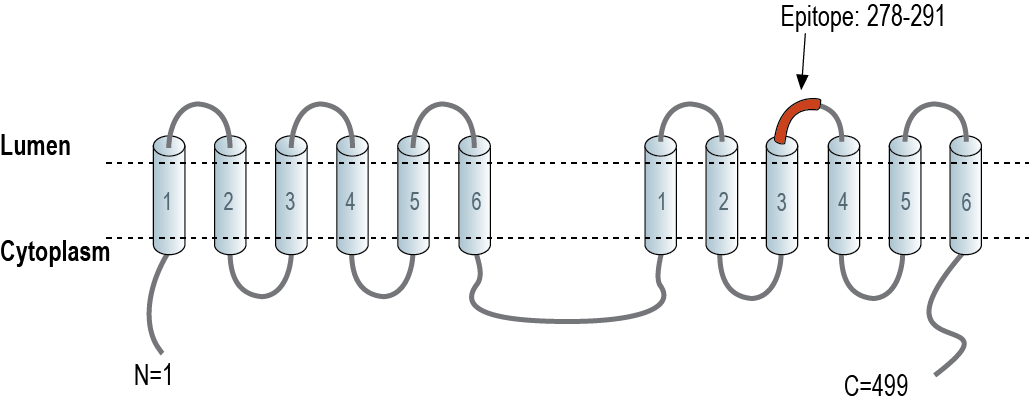Overview
- Peptide CEDNVPDPKDVQEK, corresponding to amino acid residues 278 - 291 of mouse TMEM175 (Accession Q9CXY1). Luminal, 4th loop.

TMEM175 Blocking Peptide (#BLP-PC175)
 Western blot analysis of rat spleen membranes (lanes 1 and 3) and mouse spleen lysates (lanes 2 and 4):1-2. Anti-TMEM175 Antibody (#APC-175), (1:200).
Western blot analysis of rat spleen membranes (lanes 1 and 3) and mouse spleen lysates (lanes 2 and 4):1-2. Anti-TMEM175 Antibody (#APC-175), (1:200).
3-4. Anti-TMEM175 Antibody, preincubated with TMEM175 Blocking Peptide (BLP-PC175). Western blot analysis of human SH-SY5Y neuroblastoma cell line lysate (lanes 1 and 4), human THP-1 monocytic leukemia cell line lysate (lanes 2 and 5) and human LNCaP prostate adenocarcinoma cell line lysate (lanes 3 and 6):1-3. Anti-TMEM175 Antibody (#APC-175), (1:200).
Western blot analysis of human SH-SY5Y neuroblastoma cell line lysate (lanes 1 and 4), human THP-1 monocytic leukemia cell line lysate (lanes 2 and 5) and human LNCaP prostate adenocarcinoma cell line lysate (lanes 3 and 6):1-3. Anti-TMEM175 Antibody (#APC-175), (1:200).
4-6. Anti-TMEM175 Antibody, preincubated with TMEM175 Blocking Peptide (BLP-PC175).
 Expression of TMEM175 in rat medial septum.Immunohistochemical staining of perfusion-fixed frozen rat brain sections using Anti-TMEM175 Antibody (#APC-175), (1:300), followed by goat anti-rabbit-AlexaFluor-488. A. TMEM175 immunoreactivity (green) appears in cells of the medial septum (arrows). B. Pre-incubation of the antibody with TMEM175 Blocking Peptide (BLP-PC175), suppressed staining. Cell nuclei are stained with DAPI (blue).
Expression of TMEM175 in rat medial septum.Immunohistochemical staining of perfusion-fixed frozen rat brain sections using Anti-TMEM175 Antibody (#APC-175), (1:300), followed by goat anti-rabbit-AlexaFluor-488. A. TMEM175 immunoreactivity (green) appears in cells of the medial septum (arrows). B. Pre-incubation of the antibody with TMEM175 Blocking Peptide (BLP-PC175), suppressed staining. Cell nuclei are stained with DAPI (blue). Expression of TMEM175 in mouse piriform cortex.Immunohistochemical staining of perfusion-fixed frozen mouse brain sections using Anti-TMEM175 Antibody (#APC-175), (1:300), followed by goat anti-rabbit-AlexaFluor-488. A. TMEM175 immunoreactivity (green) appears in cells of the piriform cortex (arrows). B. Pre-incubation of the antibody with TMEM175 Blocking Peptide (BLP-PC175), suppressed staining. Cell nuclei are stained with DAPI (blue).
Expression of TMEM175 in mouse piriform cortex.Immunohistochemical staining of perfusion-fixed frozen mouse brain sections using Anti-TMEM175 Antibody (#APC-175), (1:300), followed by goat anti-rabbit-AlexaFluor-488. A. TMEM175 immunoreactivity (green) appears in cells of the piriform cortex (arrows). B. Pre-incubation of the antibody with TMEM175 Blocking Peptide (BLP-PC175), suppressed staining. Cell nuclei are stained with DAPI (blue).
Transmembrane protein 175, TMEM175, is an endosomal/lysosomal proton channel that plays a crucial role in preserving the lysosomal membrane potential and maintaining pH stability. TMEM175 mediates lysosomal proton efflux, known as the “H+ leak” pathway, preventing excessive acidification of lysosomes.1
Intracellular endosomes and lysosomes rely on a vacuolar-type H+ ATPase (V-ATPase) to establish a significant proton concentration gradient across their membranes, which plays a crucial role in facilitating active transport of ions and metabolites between the vesicular lumen and the cytosol. To effectively digest macromolecules, lysosomes rely on an acidic environment with a pH range of 4.5 to 5.0, which is maintained through the entry of protons by the V-ATPase pump and their exit through the "H+ leak" pathway, which is the passive release of H+ into the cytosol. TMEM175 functions as a proton-activated, proton-selective channel on the lysosomal membrane in order to mediate the “H+ leak” pathway, prohibiting the excessive acidification of lysosomes. When lysosomes are acidified beyond the typical range, TMEM175 is activated, prohibiting further lysosomal acidification.1
Mammalian TMEM175 consists of two homologous 6-TM domains and is suggested to function as a dimer. TM1 serves as the inner helix lining the pore and forms an hourglass-shaped ion permeation pathway within the channel. The C-terminal half of TM1 contains hydrophobic residues that create a bottleneck along the ion conduction pathway, serving as the selectivity filter of the channel. TMEM175 conducts K+ constitutively at pH 7.4, but shows reduced K+ permeation at lower pH. Conversely, proton current through TMEM175 increases with decreasing pH due to the increased proton gradient. Molecular dynamics simulation, structure-based mutagenesis, and electrophysiological analysis suggest that K+ ions and protons share the same permeation pathway in TMEM175.2,3
Altered lysosomal pH disrupts various cellular processes, including lysosomal degradation, cargo loading, catabolite export, vesicle movement, and nutrient sensing. This impairment contributes to the pathogenesis of neurodegenerative diseases such as Parkinson's disease, Alzheimer's disease, and lysosomal storage diseases. Optimization of lysosomal pH can effectively clear toxic protein aggregates associated with these diseases. Thus, maintaining lysosomal pH homeostasis plays a crucial role in lysosome function, cellular health, and neuropathology.1
Application key:
Species reactivity key:
Anti-TMEM175 Antibody (#APC-175) is a highly specific antibody directed against an epitope of the mouse protein. The antibody can be used in western blot and immunohistochemistry applications. It has been designed to recognize TMEM175 from rat, mouse and human samples.
